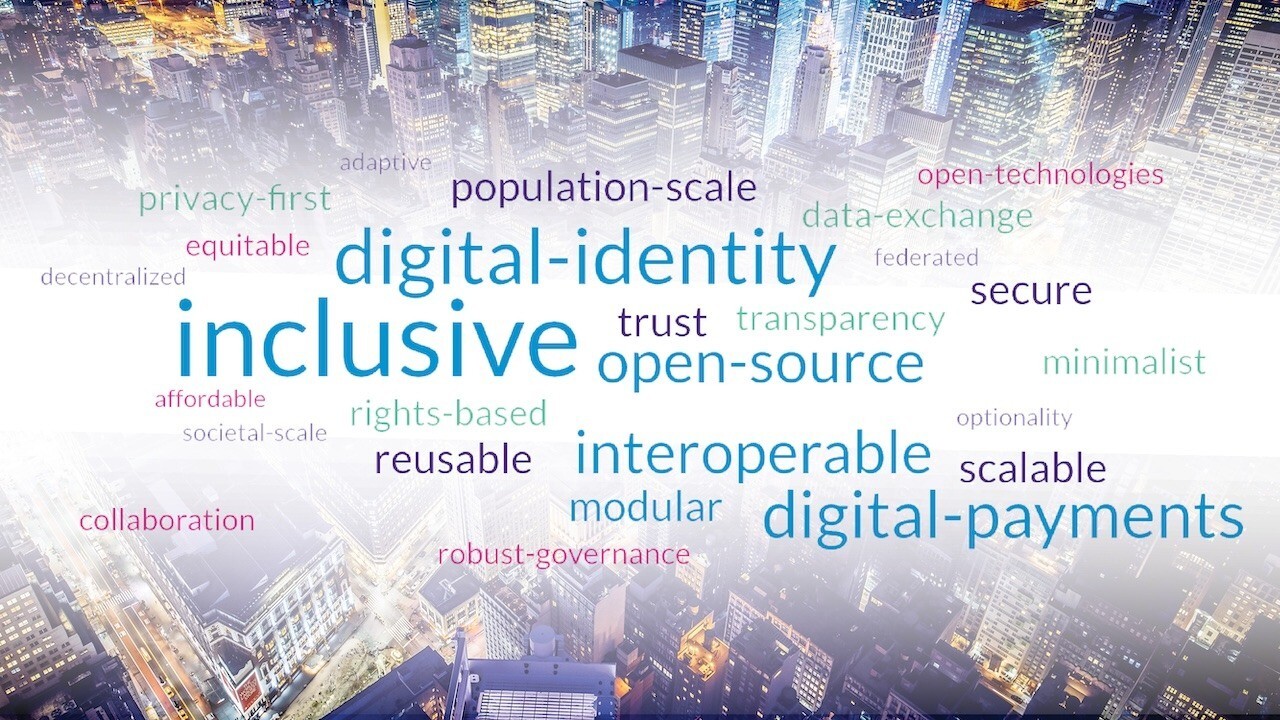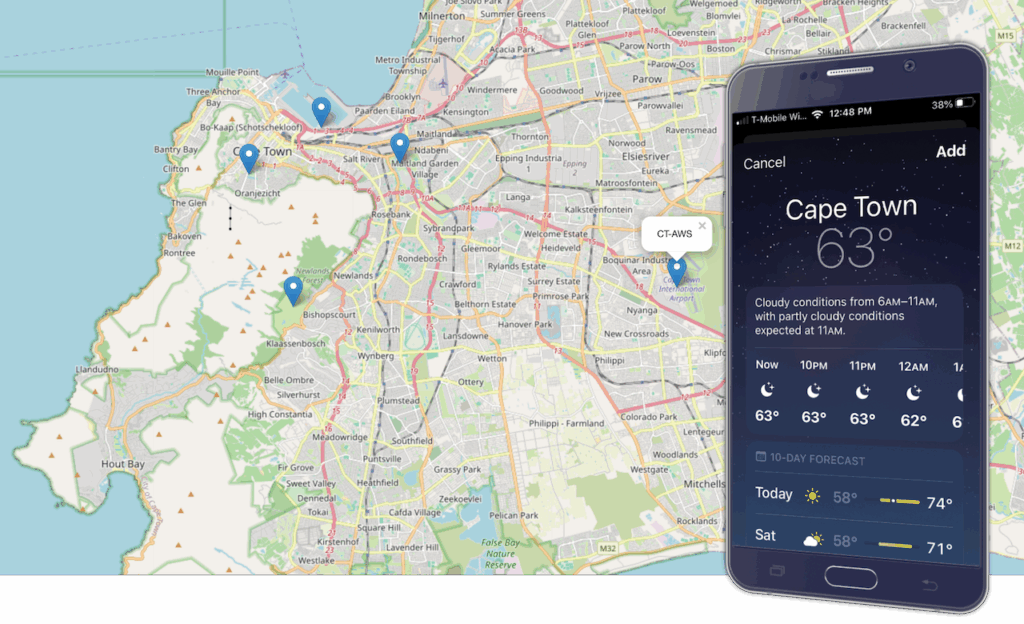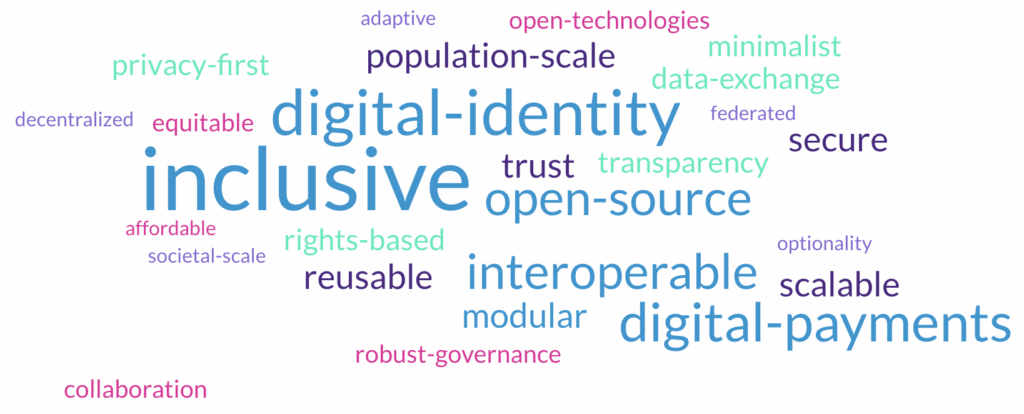
A weather app is one of the most popular applications. Weather data is consumed by a wide range of users, including the general public for daily planning, various industries like aviation, agriculture, energy, logistics, and retail for operational decision-making, governments for emergency management, financial institutions for commodity and derivative markets, marketers for targeted campaigns, and researchers for climate studies. This universal need for weather information drives consistent user engagement.
Weather data is collected by countries at their weather stations and made available as digital public goods. While raw data is available and accessible, integrating climate products into applications requires API access. API access is provided by third-parties that aggregate weather data and convert it into weather forecasts, insights, and climate products. While countries export their data, it is third-parties that monetize this data and sell it back to countries as intelligence.

How do countries avoid this trap of exporting data and importing intelligence? How do countries create the digital infrastructure that ensures that data can be efficiently consumed, effectively monetized, and ultimately leveraged to serve public good?
Digital Public Infrastructure (DPI) promises data sovereignty empowering countries to harness the full potential of their digital assets. How do countries transform DPI’s promise and potential into performance?
We outline four principles that will deliver success for countries rolling out DPI-based solutions. Before we proceed, we must first understand DPI and how it differs from the broader digital transformation of government services.
DPI Word Cloud
To understand DPI, it is illuminating to focus on the most commonly used words in conversations around DPI. The accompanying word cloud visualizes the frequency of terms used in DPI discussions, specifically sourced from LinkedIn posts tagged with the DPI hashtag.

These same words could be used to describe any digital transformation of government public services. The only difference is the frequency of the term open source. Is open source what separates DPI from digital transformation?
There are four words that are conspicuous by their absence and it is these four overlooked words that draw the line between digital transformation of government services and public services built on DPI – Saturation, Stack, Service-APIs, and SDG-metrics. These four words need to rise to the top in the frequency count in any DPI conversations. DPI success will be determined by a country’s ability to convert these four words into actions.
Saturation before Inclusion
India has a population of 1.4 billion people. Many global indexes and government metrics deem “success” at over 90% coverage of a service. At 90% coverage, 140 million people are excluded, which is greater than the population of Mexico. At 98% coverage, 28 million people are excluded, which is greater than the population of Australia. Even at 99% coverage, a population greater than the population of Greece is excluded. True success requires saturation; anything less results in exclusion.
Inclusion before saturation only widens the digital divide. As Indian companies have realized, saturation coverage is not just about social justice, but makes good business sense too [1]. A resident who is provided basic social services will, over time become a paying consumer of services. First-movers amongst Bank, Insurance, and Telecom companies have seen significant year-to-year revenue growth, post India’s DPI rollout. Saturation outreach programs have significantly lowered customer acquisition costs and India’s DPI rollout has shown that today’s beneficiary is tomorrow’s paying customer. DPI-enabled services like Direct Benefits Transfer (DBT) and government-sponsored insurance coverage moved people from welfare to workfare and enabled the transition from an informal to a more formal economy.
Foundational to DPI is 100% coverage of affordable digital access, and the skills and digital literacy to navigate the services. The rollout of DPI services in India is illustrative. India’s digital ID Aadhaar helped millions get access to services like health, education, and banks. The problem was, in the poorer regions and rural areas, health, education, and banking facilities were nonexistent. Having a digital ID did not help when the brick-and-mortar facilities delivering these services were not available or accessible.
In 2014, Prime Minister Narendra Modi launched the National Mission for Financial Inclusion called the Jan Dhan Yojana, with the goal of saturation coverage of bank accounts. Instead of people going to the banks, the banks came to the people. With the banks came electricity to power the equipment and homes, clean water and sanitation, roads to transport goods, access to services like health and education, and schools to skill youth to access and operate the digital future.
Saturation coverage of bank accounts also provided the needed momentum for UPI, India’s digital payments solution. India’s success with DPI is attributed to the JAM (Jan Dhan, Aadhaar, Mobile) trinity [1]. Jan Dhan Yojana ensured saturation coverage of bank accounts, Aadhaar ensured saturation coverage of digital authentication, and Mobile ensured saturation coverage of digital access.
Digital Stack before Digital Transformation
We have seen that for DPI to succeed, physical equity must precede digital equity. Similarly, attempting digital transformation before creating a public digital stack results in proprietary solutions, data silos, and fragmented insights.
The US spends over 18% of its GDP on healthcare (around $4.9 trillion in 2023), but healthcare remains deeply fragmented, with less than optimal patient outcomes, higher mortality rates, poor patient experience, high pharmaceutical costs, and huge amounts of waste. One of the reasons for the high costs of healthcare is fragmented data and incompatible IT systems across providers and payers [2]. The lack of an integrated digital infrastructure where patient records can be accessed seamlessly across providers and payers inflates costs and leads to medical misdiagnosis, repeat testing, inappropriate medications, and polypharmacy.
Fragmented data and the lack of a common data exchange protocol forces insurers to have to integrate with each provider’s EHR systems. This creates inefficiencies, hinders collaboration, limits insights, and increases costs. In a fragmented market, a proprietary digital transformation only leads to more fragmentation, more siloed data, vendor lock-ins, and significantly inflated integration costs.
DPI is not a service. It is an open architecture that enables the building of population-scale services. Open data and open stack APIs ensure that data is not fragmented, but federated; that data movement is not impeded, but can be exchanged seamlessly across entities. This architecture ensures local control and security of data, while enabling national access, data portability, and holistic insights.
When data is open, and services and solutions are integrated around a public digital stack, businesses and governments will be able to manage their resources efficiently, deliver services faster, and provide transparency into policies and actions, allowing for bottom-up citizen and private-enterprise driven initiatives that create new opportunities and improve the quality of life of communities.
Open API before Open Source
The DPI word cloud features open source at a much higher frequency than open API or open data. Open source is software where the source code is made available and can be used as-is, modified, enhanced, and freely distributed. While the software is technically free, the total cost of ownership is hard to measure and quantify. As the source code is public, it also opens itself to malicious actors who can exploit vulnerabilities in the code. For open source software to be successful, it requires a critical mass of developers actively contributing to it, who can detect and fix vulnerabilities and identify any backdoors.
Open source also ties you to a specific computer language and implementation. If Aadhaar were coded in Java, and you open source it, then the only option is to implement Digital Identity in Java. It also may have dependencies on older versions of libraries that may in turn have known vulnerabilities. It restricts an entity from taking advantage of more modern computer languages, or adapting it to locally available skill sets, or utilizing security through obfuscation, which a proprietary implementation provides.
Open source software can be modified; its data models and even its APIs changed. Open source software needs to be compiled, packaged, containerized, deployed, secured, scaled, monitored, managed, and periodically patched. Instead of interoperability, what you get are proprietary data silos. Instead of open source, the focus should be on open APIs and open data. This provides flexibility and will not constrain other countries to a specific implementation or language. Open data and open APIs are also key to creating data exchanges.
Open API fosters innovation, enhances operational efficiency, and provides significant value to the provider, developers and partners who build applications and services on it.
Open source creates dependency. Open data and open APIs create ownership and encourage collaboration. Developers building population-scale services on DPI need well-documented APIs, sandboxes to test out their APIs, developer support for enhancements and feature requests, and a certification process to activate their applications and services.
SDG Metrics before Usage Metrics
The success of a digital transformation is measured by usage metrics. Usage metrics measure adoption and engagement with the service. These metrics are not an indicator of the quality of life of the community.
There is already a global consensus on SDG metrics that provides a measure for a community’s socio-ecological progress. The impact of DPI on a community will be measurable as progress in SDGs on hunger, health, education, gender equity, access to water/sanitation/power, clean air, and water.
The Metraa (Measure/Track/Reform/Accelerate/Achieve) framework [3] leverages open data, digital transformation, DPI, and sustainable models of service delivery. It provides a consistent way for measuring SDG status, transparency into progress towards targets, and an accelerated path towards achieving them.
Four S’s to DPI Success
We can now answer how countries can maintain data sovereignty and avoid exporting data and importing intelligence.
Success with DPI is conditional on the 4 S’s – Saturation, Stack, Service-APIs, and SDG-metrics. It is these four S’s that we need to surface to the top in any DPI conversations. Saturation ensures that no one is left behind, and early movers among the service providers benefit from low customer acquisition costs, customer loyalty, and increased profits. Stack ensures that data is not fragmented but federated, and significantly reduces duplication of work and avoids fragmented analytics. Service-APIs increase collaboration, increase citizen and private enterprise engagement, and allow localized solutions. SDG-metrics provide a true measure of DPI’s impact, providing clarity and actionable intelligence into gaps and the targeted investments needed to accelerate the achievement of SDGs.
Without saturation, there is exclusion. Without a stack, there is no digital infrastructure. Without service APIs, there is no pathway to access the stack, and what remains are proprietary data silos. Without SDG metrics, there is no way of measuring impact.
Prioritizing these 4 S’s will ensure that data can be efficiently consumed, effectively monetized, and ultimately leveraged to serve public good. It will create responsive governments, resilient communities, and a sustainable planet.
References
[1] The DPI Playbook – Data First, Not Digital First – https://hawkai.net/the-dpi-playbook-data-first-not-digital-first/
[2] Delay, Deny, Detect – https://hawkai.net/delay-deny-deduct/
[3] Achieving SDGs – An Actionable Framework – https://hawkai.net/achieving-sdgs-an-actionable-framework/
Learn more about DPI – https://hawkai.net/digital-public-infrastructure/
Learn more about SDG – https://hawkai.net/sustainable-development/
Learn more about building friction-less population-scale services on DPI – https://hawkai.net/customer-experience/
Learn more about how a Digital Public Healthcare Stack can deliver universal and affordable healthcare – https://hawkai.net/health-care/
Header Photo Credits: Image by Denys Nevozhai on Unsplash








